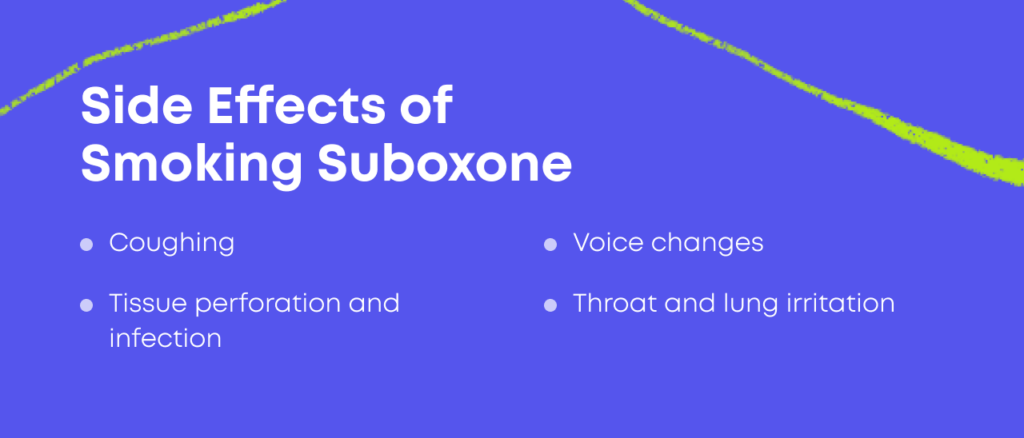
Quick Answer
You cannot smoke Suboxone. Any high you might get from this method would be so mild that you wouldn’t notice it.
Suboxone is a prescription medication used to ease opioid withdrawal and cravings. If you have a prescription for Suboxone, you’re presumably using this medication to treat an opioid use disorder (OUD), although it is sometimes also used as a pain medication in patients who do not have OUD.
While it’s theoretically possible to smoke Suboxone by dissolving the strip or crushing the tablet and then smoking the powder, it would be difficult to do and would not likely produce a “high”. In addition, it could be highly dangerous.
Can You Smoke Suboxone?
Not really, no.
Suboxone comes in several forms, including pills, films, patches and injectables. While it is possible to crush and smoke the pill form of Suboxone or dissolve and then smoke the powder from the strip form, it is difficult to do and probably not effective at producing a “high”. More importantly, it is dangerous and considered a misuse of the medication.
Strips are very difficult to turn into powder, so it’s not really possible to smoke them.[1] Strips can’t be smoked in their pure form, as they won’t catch fire. Dissolving strips and inhaling the vapors isn’t effective either.
Can You Snort Suboxone?
Snorting Suboxone works in much the same way as smoking. People who snort Suboxone find that the high is mild, if even present at all. Thus, most people do not misuse Suboxone by snorting it.[2]
Can You Misuse Suboxone?
The buprenorphine in Suboxone is a partial opioid agonist, which can cause euphoria if used by someone who is opioid naïve. However, it is weaker than oxycodone or heroin, so it can prevent withdrawal symptoms without getting a person “high” like a full opioid agonist might.
Of people using buprenorphine, 75% report taking it always as prescribed. [3] Most people take the drug to manage an opioid use disorder. Suboxone is an important and sometimes life-saving medication for these individuals.

The Risks & Dangers of Smoking Suboxone
Suboxone, whether in pill or strip format, is made to dissolve inside your mouth. Chemists never designed Suboxone to move into your body through your lungs. Attempting to smoke Suboxone can lead to serious side effects.
There is little research surrounding the specific effects of smoking Suboxone; however, smoking any drugs can cause the following:[4]
- Coughing
- Throat irritation
- Voice changes
- Lung irritation or damage
- Tissue perforation and infection
Buprenorphine in Suboxone has a ceiling effect, so it doesn’t produce more euphoria when you take more. And the naloxone in Suboxone kicks in when you take too much buprenorphine, blocking the drug’s euphoric potential.
If you attempt to smoke Suboxone, these two ingredients could keep you from experiencing the high you hoped for. You may feel very little or nothing at all, or you could feel sick.
People who misuse Suboxone and activate naloxone can experience severe withdrawal symptoms. They can include the following:
- Nausea
- Diarrhea
- Anxiety
- Insomnia
- Bone aching
- Severe drug cravings
Misusing Suboxone can also increase your relapse risks. If you try to manipulate your dose and can’t get high, you could shift to hard drugs again. Of all Suboxone smoking risks, this is the most severe.
Is Suboxone Addictive?
The buprenorphine in Suboxone is a partial opioid agonist, and experts say it has a mild addictive potential.[4] It doesn’t bind to brain receptors as strongly as drugs like heroin and OxyContin. And it doesn’t trigger the intense euphoria associated with these drugs. Therefore its “addiction” potential is very low, especially compared to full opioid agonists like Oxycodone or heroin. For these reasons it is used as a treatment for addictions to those medications or drugs.
Long-term Suboxone use is life saving for many people with OUD. When they use their medication as directed, they don’t feel drug cravings and are able to minimize or even abstain completely from opioid misuse.
Suboxone misuse risks are present. But know that the vast majority of people don’t misuse their medication. Instead, they use their prescriptions to keep their OUD under control, so they can lead a healthy life free from addiction.

Reviewed By Peter Manza, PhD
Peter Manza, PhD received his BA in Psychology and Biology from the University of Rochester and his PhD in Integrative Neuroscience at Stony Brook University. He is currently working as a research scientist in Washington, DC. His research focuses on the role ... Read More
- Winstock A. Buprenorphine use by the smoking route in gaols in NSW. Drug and Alcohol Review. 2008;27(4):449-450. https://www.tandfonline.com/doi/abs/10.1080/09595230802043807?journalCode=idar20
- Walsh S, Nuzzo P, Babalonis S, Casselton V, Lofwall M. Intranasal buprenorphine alone and in combination with naloxone: Abuse liability and reinforcing efficacy in physically dependent opioid abusers. Drug and Alcohol Dependence. 2016;162:190-198. https://doi.org/10.1016/j.drugalcdep.2016.03.005
- Buprenorphine misuse decreased among U.S. adults with opioid use disorder from 2015-2019. National Institutes of Health. Published October 15, 2021. Accessed August 7, 2023. https://www.nih.gov/news-events/news-releases/buprenorphine-misuse-decreased-among-us-adults-opioid-use-disorder-2015-2019
- American Psychiatric Association. (2013). Diagnostic and Statistical Manual of Mental Disorders(5th ed.). https://doi.org/10.1176/appi.books.9780890425596
Download Our Free Program Guide
Learn about our program, its effectiveness and what to expect
Related Content
Imagine what’s possible on the other side of opioid use disorder.
Our science-backed approach boasts 95% of patients reporting no withdrawal symptoms at 7 days. We can help you achieve easier days and a happier future.
